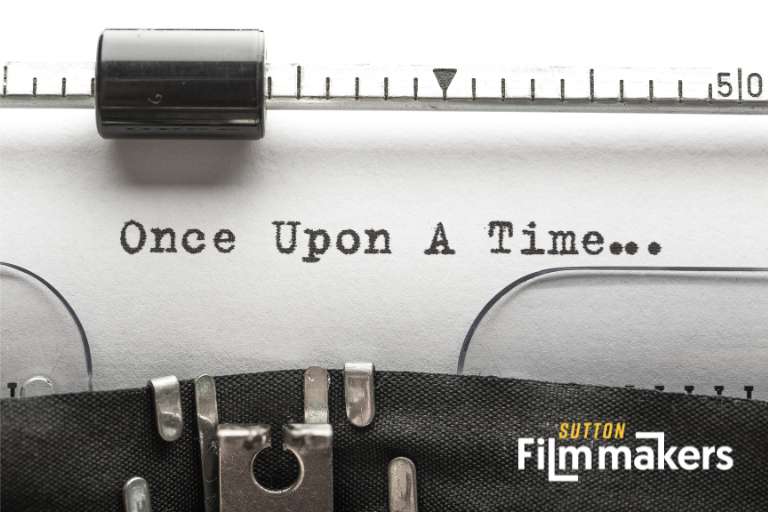
- This event has passed.
Screen writing practical
Focusing on developing a script for the making a film in a night challenge
Led by Sara Jordan
May 21 @ 7:45 pm – 10:00 pm
Screen writing part 1
Award winning writer/director/actor Sara Jordan will be leading a screen writing evening. The first part of the session will be looking at how to write dialogue .. what are the pitfalls and how to find a characters voice.
Sara has demonstrated many times before how she can help you to reach deep down into your creative mind, to develop a screen writing idea that you had no idea was there. You will probably surprise yourself.

What is a characters voice?
In screen writing and storytelling, a character’s voice refers to the unique way in which they express themselves, both verbally and non-verbally. It encompasses not only what a character says, but also how they say it, their tone of voice, body language, gestures, and overall personality.
Character voice is a crucial element in defining and differentiating characters within a story. It helps to establish their identity, motivations, emotions, and worldview. A character’s voice should be consistent with their traits, background, and the context of the story.
For example, a character’s voice may be:
- Verbal: This includes the words they use, their vocabulary, speech patterns, accent, and dialect. A character may speak formally or casually, use slang or technical jargon, depending on their background and personality.
- Tone and Delivery: The tone of voice reflects the character’s emotional state, attitude, and intentions. It can range from confident and assertive to timid or uncertain. The delivery of lines, including pacing, volume, and emphasis, also contributes to the character’s voice.
- Non-verbal Communication: Body language, facial expressions, and gestures convey a character’s emotions, intentions, and personality traits. These non-verbal cues complement their verbal communication and provide additional depth to their voice.
Overall, a character’s voice is a multifaceted aspect of and screen writing story that helps to bring them to life and engage the audience in their journey. It’s a powerful tool for writers, directors, and actors to develop rich, complex characters that resonate with viewers.
Screen writing part 2
The second part will be a challenge in order to come up with an idea for a short film which will be filmed at the next session. There will be 3 genres of film for which ideas will be generated, the group will decide on the best idea for each genre and then those 3 will be filmed guerrilla style in small teams with only 2 hours minutes to film it.
There will be 2 weeks between each session so props and costumes could be sourced if required.
Be a Guerrilla for the evening
Guerrilla filmmaking, also known as guerrilla-style filmmaking, is a method of filmmaking characterised by its low-budget, independent approach and its focus on speed and efficiency. In essence, it involves using minimal resources, often limited equipment, and a small crew to quickly produce a film under unconventional circumstances.
In the context of our club meet where we’re making a film in just two hours, guerrilla filmmaking can be a highly effective approach. Here’s how members can utilize it:
- Limited Resources: Embrace the challenge of working with limited resources. Instead of letting it hinder creativity, use it to your advantage by thinking outside the box and finding innovative solutions to overcome obstacles.
- Speed and Efficiency: With limited time available, prioritize speed and efficiency in every aspect of the filmmaking process. Plan your shots in advance, make quick decisions on set, and keep the momentum going to maximize productivity.
- Flexibility: Be prepared to adapt to changing circumstances on the fly. Guerrilla filmmaking often involves shooting in real-world locations with minimal control over the environment. Embrace spontaneity and be ready to adjust your plans as needed to make the most of the available resources.
- Small Crew: Work closely with a small, dedicated crew to streamline the filmmaking process. Assign clear roles and responsibilities to each team member to ensure smooth coordination and collaboration throughout the shoot.
- Creative Problem-Solving: Guerrilla filmmaking requires creative problem-solving skills to overcome challenges and limitations. Be resourceful and think creatively to find solutions to any obstacles that may arise during the shoot.
By embracing the principles of guerrilla filmmaking, our members can effectively utilise their time and resources to produce a compelling film in just two hours. It’s all about embracing the constraints and finding creative ways to turn them into strengths.
Guerrilla or Gorilla?
Guerrilla comes from the Spanish word for a war made up of skirmishes. That guerilla is related to guerra for (you guessed it), war. If you remember that guerra is war and guerrilla is little war, you’ll remember that in English, independent fighters are guerrillas, no matter how hairy they are.
